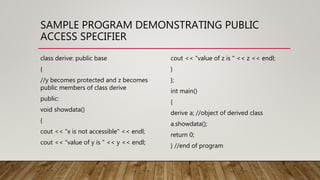Access specifier
- 2. C++ ACCESS SPECIFIERS C++ access specifiers are used for determining or setting the boundary for the availability of class members (data members and member functions) beyond that class. For example, the class members are grouped into sections, private protected and public. These keywords are called access specifiers which define the accessibility or visibility level of class members. By default the class members are private. So if the visibility labels are missing then by default all the class members are private. In inheritance, it is important to know when a member function in the base class can be used by the objects of the derived class. This is called accessibility and the access specifiers are used to determine this.
- 3. C++ ACCESS SPECIFIERS Access specifier can be either private or protected or public. In general access specifiers are the access restriction imposed during the derivation of different subclasses from the base class. private access specifier protected access specifier public access specifier
- 5. VISIBILITY MODES Public: When the member is declared as public, it is accessible to all the functions of the program. Private: When the member is declared as private, it is accessible within the class only. Protected: When the member is declared as protected, it is accessible within its own class as well as the class immediately derived from it.
- 6. PRIVATE ACCESS SPECIFIER • If private access specifier is used while creating a class, then the public and protected data members of the base class become the private member of the derived class and private member of base class remains private. • In this case, the members of the base class can be used only within the derived class and cannot be accessed through the object of derived class whereas they can be accessed by creating a function in the derived class.
- 8. SAMPLE PROGRAM DEMONSTRATING PRIVATE ACCESS SPECIFIER • Note: Declaring data members with private access specifier is known as data hiding. #include <iostream> using namespace std; class base { private: int x; protected: int y;
- 9. SAMPLE PROGRAM DEMONSTRATING PRIVATE ACCESS SPECIFIER public: int z; base() //constructor to initialize data members { x = 1; y = 2; z = 3; } }; class derive: private base { //y and z becomes private members of class derive and x remains private public: void showdata() { cout << "x is not accessible" << endl; cout << "value of y is " << y << endl; cout << "value of z is " << z << endl; }
- 10. SAMPLE PROGRAM DEMONSTRATING PRIVATE ACCESS SPECIFIER }; int main() { derive a; //object of derived class a.showdata(); return 0; } //end of program Output x is not accessible value of y is 2 value of z is 3
- 11. EXPLANATION • When a class is derived from the base class with private access specifier the private members of the base class can’t be accessed. So in above program, the derived class cannot access the • So in above program, the derived class cannot access the member x which is private in the base class, however, derive class has access to the protected and public members of the base class. So the • Hence the function showdata in derived class can access the public and protected member of the base class.
- 12. PROTECTED ACCESS SPECIFIER • If protected access specifier is used while deriving class then the public and protected data members of the base class becomes the protected member of the derived class and private member of the base class are inaccessible. • In this case, the members of the base class can be used only within the derived class as protected members except for the private members.
- 14. SAMPLE PROGRAM DEMONSTRATING PROTECTED ACCESS SPECIFIER #include <iostream> using namespace std; class base { private: int x; protected: int y; public: int z; base() //constructor to initialize data members { x = 1; y = 2; z = 3; } };
- 15. SAMPLE PROGRAM DEMONSTRATING PROTECTED ACCESS SPECIFIER class derive: protected base { //y and z becomes protected members of class derive public: void showdata() { cout << "x is not accessible" << endl; cout << "value of y is " << y << endl; cout << "value of z is " << z << endl; } }; int main() { derive a; //object of derived class a.showdata(); return 0; }
- 16. SAMPLE PROGRAM DEMONSTRATING PROTECTED ACCESS SPECIFIER Output x is not accessible value of y is 2 value of z is 3
- 17. PUBLIC ACCESS SPECIFIER • If public access specifier is used while deriving class then the public data members of the base class becomes the public member of the derived class and protected members becomes the protected in the derived class but the private members of the base class are inaccessible.
- 19. SAMPLE PROGRAM DEMONSTRATING PUBLIC ACCESS SPECIFIER #include <iostream> using namespace std; class base { private: int x; protected: int y; public: int z; base() //constructor to initialize data members { x = 1; y = 2; z = 3; } };
- 20. SAMPLE PROGRAM DEMONSTRATING PUBLIC ACCESS SPECIFIER class derive: public base { //y becomes protected and z becomes public members of class derive public: void showdata() { cout << "x is not accessible" << endl; cout << "value of y is " << y << endl; cout << "value of z is " << z << endl; } }; int main() { derive a; //object of derived class a.showdata(); return 0; } //end of program
- 21. SAMPLE PROGRAM DEMONSTRATING PUBLIC ACCESS SPECIFIER Output x is not accessible value of y is 2 value of z is 3




















